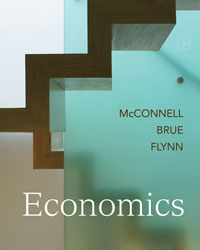
Economics (McConnell), 18th EditionChapter 14: Rent, Interest, and ProfitKey Questions1. Explain why economic rent is a surplus payment when viewed by the economy as a whole but a cost of production from the standpoint of individual firms and industries. Explain: "Land rent performs no 'incentive function' for the overall economy." 2. Why is the supply of loanable funds upsloping? Why is the demand for loanable funds downsloping? Explain the equilibrium interest rate. List some factors that might cause it to change. 3. Suppose that the interest rate is 4 percent. What is the future value of $100 four years from now? How much of the future value is total interest? By how much would total interest be greater at a 6 percent interest rate than at a 4 percent interest rate? 4. Distinguish between nominal and real interest rates. Which is more relevant in making investment and R&D decisions? If the nominal interest rate is 12 percent and the inflation rate is 8 percent, what is the real rate of interest? 5. How do the concepts of accounting profit and economic profit differ? Why is economic profit smaller than accounting profit? What are the three basic sources of economic profit? Classify each of the following according to those sources:
|  |















